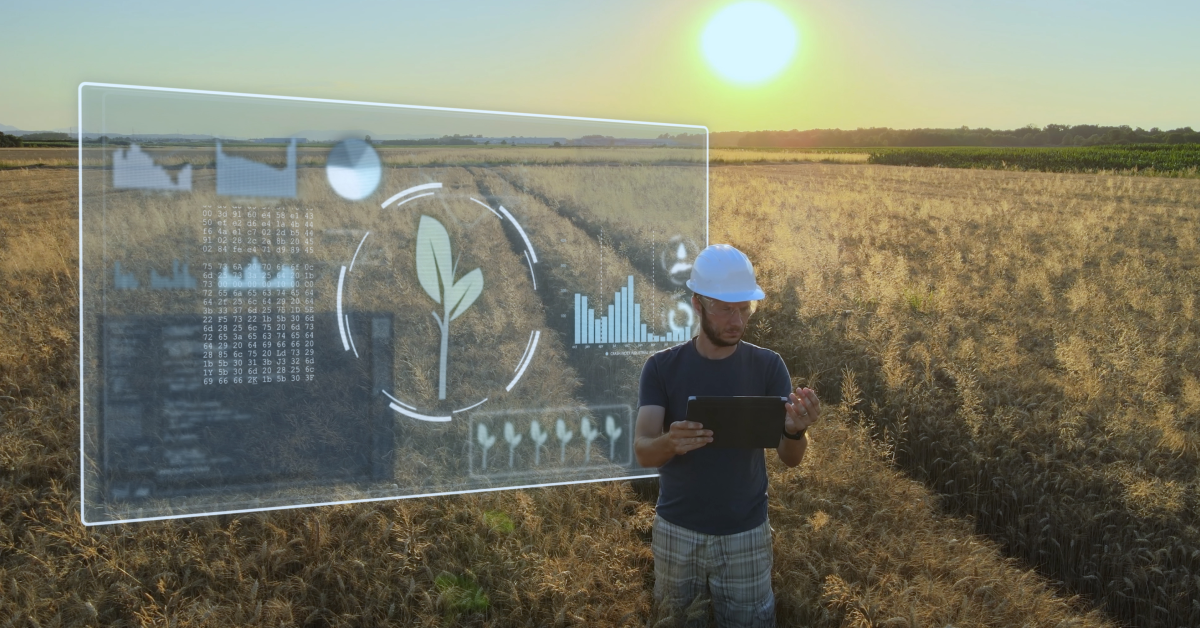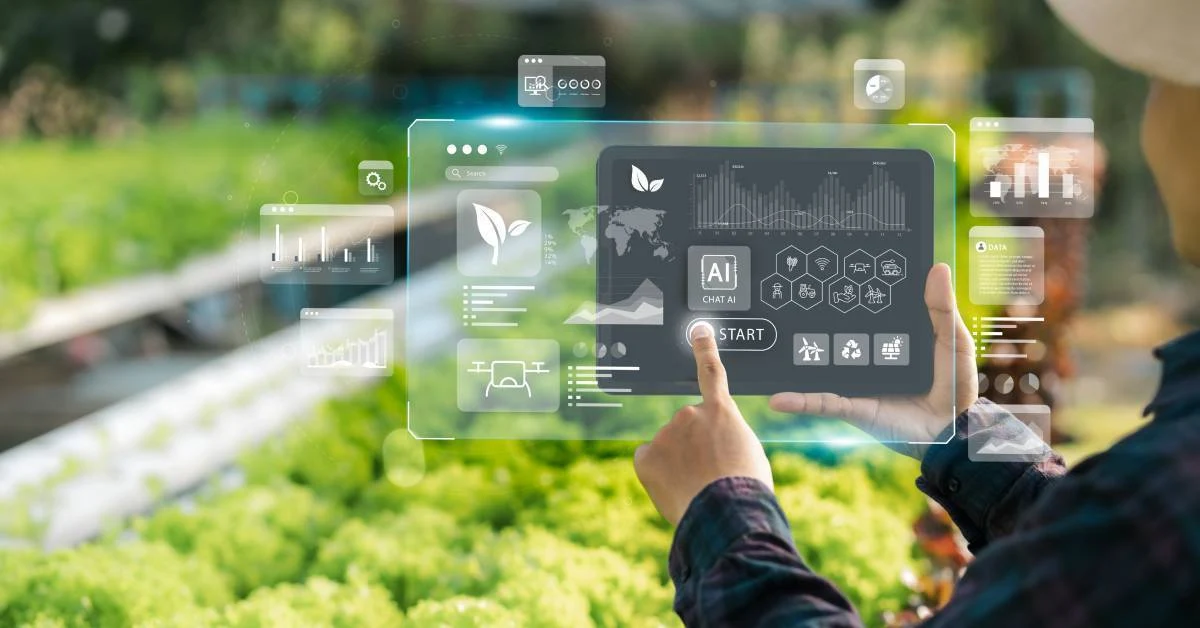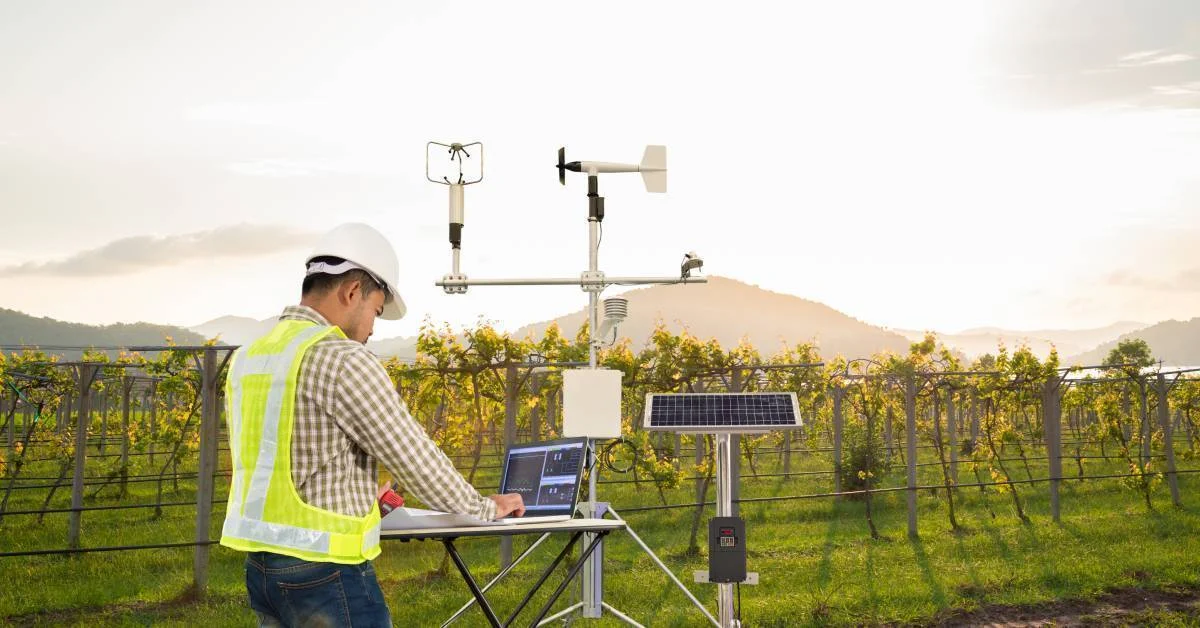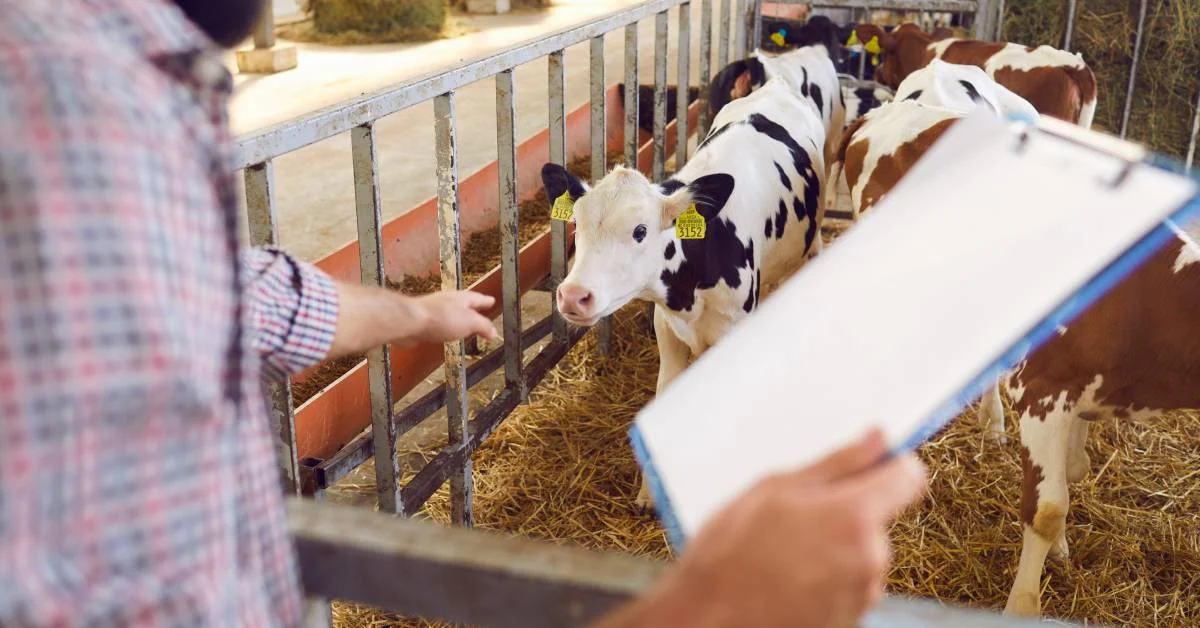The agricultural revolution, as we know it today, dates back to the 18th century when the need for a fundamental change, which was both efficient and effective, was recognized in Britain as the need for ‘more food’ surfaced. Hence, the need for a balance in the agricultural economy was seen due to the increasing population. This realization
gave birth to a revolution that is known to be the perpetuating cause of the Industrial Revolution itself.

Therefore, from the first revolution to the third, the agricultural sector has seen success like none other and has become a pent amount for a brighter, more surplus future pertaining to more yield and easier, more convenient farming throughout the years.
However, the fourth revolution is being predicted as a one-of-a-kind manoeuvre which would change the scope of the agricultural sector altogether. But the question here stands: are we ready for what is about to come? While scientists and businessmen might claim that the 4AR would have immense positive effects, one cannot simply assume that these effects would present themselves without a cost.
How technology is changing the way we farm, from seed to harvest
“It’s really just about innovation. We’re looking for opportunities to make jobs easier. This is a chance to really get some tools in there.” – Susan Carroll-Boser (June 2, 2022)
This statement may make the use of AI technologies in farming and agriculture seem very mundane, but the statistics prove otherwise. Globe Newswire reported that the global Connected Agriculture market is expected to project a notable CAGR of 18.9% by 2030. It can therefore be easily witnessed how the mere incorporation of technology and automation in the agricultural department can yield phenomenal results, especially in terms of economic growth.
However, one cannot argue with how the overall system exceptionally evolved and transformed from a hunter-gathering process to one with proper scientifically-led farming societies throughout decades. One might even agree that this ‘modernization’ was very much a necessity in order to provide for a rapidly increasing population, which isn’t exactly wrong on any terms. Hence, further such advancements are being seen today as inevitable and a necessity which cannot be ignored.
These technological advancements in the agricultural sector are not just limited to hardware and practicality, but they also apparently include various scientifically engineered software that could bring the information processing abilities right at the farmers’ fingertips and help them store and manipulate data and operations easily. Such software systems include digital software for cattle processing plants, meat processing software, poultry processing management software, pork processing software, crop production software and plant maintenance software systems.
What is the Fourth Agricultural Revolution, and what are its implications for farmers and food producers?
The fourth Agricultural Revolution, or as scientists prefer to call it, the fourth Industrial Revolution, refers to integrating technology to further aid in the farming system in order to bring about a change that would alter the known ancient ways of crop and yield output altogether. This technology particularly includes the use of software and machinery utilizing Artificial Intelligence (AI).
This integration can possibly aid in tasks such as:
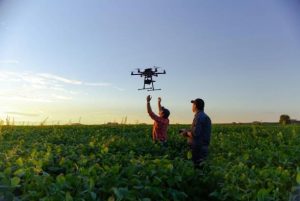
- Milking the stock
- Weeding
- Picking
- Growing crops
- Gene-editing
- Seed genomics
- Organizing output data in a more systematic manner through drones and robotics.
Scientists and politicians are inclined towards materializing this revolution for the sole purpose of minimizing environmental degradation and also to boost crop production for the increasing population. They term it as the key to solving all farming problems and challenges once and for all, for it is, after all, central to economic growth.
Scientists, farmers and politicians have therefore invested continuously in Agriculture Technology (AgTech). An overall $6.7 billion have been invested in the past 5 years. These investments are being made in the form of
- Farm automation
- Inclusion of artificial intelligence (AI)
- Vertical farming
- Blockchain
- Modern greenhouse farming, etc.
The Smart Farming
Through farm automation, farmers optimize the livestock production cycle. It is known as a type of ‘smart farming’ in which even the most mundane tasks, for example watering and harvesting, are done by robots and drones in order to make up for the labor shortage. Some of such technological advancements include:

- Robotic harvesters
- Autonomous tractors
- Automatic watering
- Seeding
This method, can hence be proven as a way of reducing continuous production costs and also to grow crops exactly according to customer preferences.
Inclusion of AI:
Farmers, by incorporating the use of AI (satellites and sensors) in their farming processes, can easily monitor
- Plant health
- Soil condition
- Water availability
- Changing weather conditions (temperature, humidity, etc).
Such statistical information can be accessed by the farmers anytime and anywhere due to remote sensitivity, and can reduce the chances of uncertainties affecting crop production and the overall yield by predicting possible outcomes. Therefore, at the end of the day, farmers can be confident about their decisions regarding productivity and material usage and can effectively achieve their goals.
Indoor Vertical Farming:
Through Indoor Vertical Farming, farmers can increase their overall crop yields and also minimize their chances of environmental degradation by limiting travelling through the supply chain.
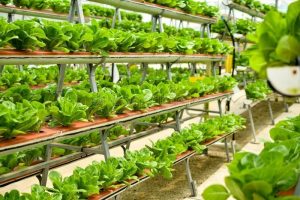
It occurs in a closed and controlled environment in which crops are grown one over the other in a standardized manner. This also efficiently divides the land by making space for other such produce. This type of farming is divided into two basic types:
- Hydroponic: Farmers grow plants in a nutrient-dense bowl of water.
- Aeroponic: The roots of the plants are densely sprayed with water and nutrients.
Hence, this method can also prove efficient by controlling water, energy, light and humidity. This energy and water-saving strategy optimizes energy conservation, since vertical farms have been proven to use 70% less water than normal farms.
Blockchains:
Due to their unique regionalized structure, blockchains can easily track ownership records and ensure transparency by solving problems such as
- Supply chain inefficiency
- Food traceability
- Food fraud
This method particularly has been proven the most essential as well as effective as mistakes and risks in terms of food quality and quantity cannot be afforded by farmers and landowners as such mistakes could potentially affect human lives.
Blockchain also aids in storing relevant data in the form of information of each individual spread along the supply chain in order to make traceability more accessible and trustworthy in times of need. It is also a very relevant player in the market by balancing product pricing, as the data it combines from the entire supply chains paints a complete picture of the apparent supply and demand.
Greenhouses:
The concept of greenhouses has had a long journey through the years, from being built solely for research purposes to actual modern farms incorporating production and yield. These modern greenhouses are
- Large-scale
- Capital-infused
- Urban-centered
They professionally manipulate the growing environment in terms of light and other such conditions to ensure proper production of crops. This manipulation enables farmers to grow crops outside of their seasons as well. Statistics show that, currently, the entire global greenhouse market produces nearly $350 billion in vegetables annually.
Opportunities for businesses, consumers, and society as a whole
Positioning one’s business in the global market is indeed a goal of every business-owner and, from the looks of it, the agricultural revolution which is on its way to change the course of agriculture completely, could possibly bring immense opportunities for all who seek to expand their businesses and make their way into the hearts of their customers.
Adopting AI infused technologies into their systems will aid them in advancing their traditional ways into ones inspired by technological innovations.
“In a future that comprises vertical farming and innovative manufacturing techniques for alternative proteins, industry can minimize the land used for food production”, said Gove.
“With vegetables growing in temperature, moisture, and nutrition controlled indoor environments, we can guarantee improvements in yield while at the same time limiting environmental externalities”, he continued.
Opportunities for Farmers and Business-owners
Techniques such as vertical farming and farm automation can evidently reduce the land space occupied and also result in lower travelling costs through the supply chain. Smart farming can help farmers in satisfying the larger market by meeting the demands of the growing population and also tackle the problems of labor shortage and skills.
Livestock is a huge component of food production, hence, this sector cannot be neglected under any circumstance. History has showed that by digitalizing financial records, supervision, and keeping track of data of feedstuffs of animals, farmers can enhance the productivity capacity and also improve the quality of production.
Opportunities for Consumers
The consumers and societies can therefore benefit from this advancement as individuals owning food businesses in the urban areas would see the improving quality of food as a chance to score higher in the market as mistakes in terms of poor quality can potentially threaten public health, while food grown and produced artificially, under controlled conditions and sealed and packaged by AI can be trusted by the masses for its unwavering history and error-free performance.
Reduction of labor from the farmlands would also appear as an opportunity for those seeking to move towards the countryside for work. This movement would add up to further industrial advancement.
What challenges does the Fourth Agricultural Revolution present to farmers?
While the fourth Agricultural Revolution might lead to dramatic positive outcomes for the agricultural sector, one simply cannot ignore the possible negative consequences that may follow.
The first highlight of the revelation that presented itself as a threat to farmers is the ‘limitation of labor’. As AI takes the limelight and handles most of the tasks for the owners, individuals working as labor suffer. While mechanization and automation may make farming more efficient, it also threatens the labor folk for taking their place in the system.
And while people like April Walker may argue that
“technology advancements will allow employees to build skills for the future”,
the fact that these skills will not be easily accessible by individuals belonging to the lower-class status quo. Some even prefer to call this expected advancement as automated oppression which could possible lead to mass unemployment.
On the other hand, while a farmer may be glad for not having to tread around his farm 24/7 to observe the progress and position of his crops, having to continuously monitor and keep track of the data provided by automation is not really everyone’s piece of cake.
One can also not simply assume that each farmer or food producer would have the necessary funds or resources to buy and maintain devices needed to control the machinery and software and easily deal with the information overload. Farmers, no matter how aged, must also be technically skilled enough to become a part of this ‘revolutionary change’.
The fourth agricultural revolution might also result in a power imbalance among the farmers as it is not only limited to dividing land or purchasing new raw material but it particularly involves buying and installing new machinery and software on one’s land in order to match the productivity and output of the other farmers who are
- Financially more sound
- Possess the necessary IT skills
- Have broadband availability
- Have ties with the larger market
Hence, larger farm business might benefit more from this movement than others. While The 4AR might seem revolutionary to most farmers, to some, it may seem like a nightmare; a kind of challenge they are not yet ready for.
The NFU has said that the fourth agricultural revolution is
“Exciting – as well as a bit scary … but then the two often go together”.
All-in-all, whatever this may lead to, let’s all hope that it blossoms into a positive change for all parties, no matter what the case.
How Can You Prepare Your Business for the Fourth Agricultural Revolution?
As a businessman or a farmer, one cannot simply sit hand-in-hand while the world around him rises to inevitable power; it is a survival of the fittest, after all. Therefore, it is absolutely prudent to bend according to the needs of the time in a manner that would be accommodating for the revolutionary changes that are about to take place.
Individuals must assess where their companies lie in terms of status quo to adopt the necessary strategies to transform and adjust according to the rapid technological advancements in the industry.
The first and foremost move would be to install the essential devices, broadband facilities and software systems needed to accommodate the technological advancements. Such software systems include
- Cattle farm management software
- Animal production management software
- Digital software for cattle farm
- Cattle record keeping software
Digitization would be the second good move; to evolve from practicality and tactility to a complete digital representation of relevant data. Transformation towards digital and software-based practices could modernize a business according to the revolutionary requirements. Utilizing digital technologies to improve the quality of programming and processing of information equips an individual with the right keys towards advancement.
Moving towards a complete digital transformation by forming affiliations with cattle management software companies would also help business in expanding and boosting their production output. Permanently switching to digital platforms to promote change and optimize business processing can help deliver more accurate results, which could pave the way towards efficiently achieving goals of the organization.
Hence, digitally mature companies and businesses would definitely find themselves standing in a far better place when the fourth agricultural revolution arrives as these would check almost all the boxes necessary to perform better financially, and in terms of performance and production; obtaining a firmer, more resilient position in the overall market.
For businesses, companies and farmers to be flexible is very crucial since adopting to the technological changes brought by the revolution could enable them in better analytics-led decision-making and product development through predictive analysis.
Folio3 is here to help!
Equipped with all the information regarding the most advanced software systems and the instructions regarding how to arm them, Folio3 Software is your go-to place for insights in technological advancements and innovations which will provide all businessmen, farmers and citizens alike with the right tools and ingredients needed to upgrade one’s skill set and knowledge to excel exceptionally, no matter what the challenges, in this very revolution.
FAQs:
Q: How the Fourth Agricultural Revolution will change the way we produce food?
Although food is being produced in our world since eons but due to the technological advancements the 4AR will bring, food will now be easily tracked, made, stored and utilized in a much more systematic manner. Plants and crops, thanks to vertical farming, can be grown vertically in greenhouses while saving up ample farming space and its quality and growth can easily be monitored through AI controlled robots and drones.

